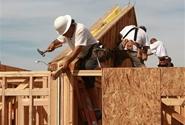Steel Markets

January Construction Employment at Highest Level Since 2008
Written by Sandy Williams
February 5, 2017
Construction employment was at its highest level since 2008 in January, according to data analyzed by the Associated General Contractors of America. The total could be much higher if there were more skilled workers available to hire, said AGC chief economist Ken Simonson. The press release from AGC follows:
Construction employment increased by 36,000 jobs in January to the highest level since November 2008 as employers increased pay in an effort to address a chronic worker shortage, according to an analysis of new government data by the Associated General Contractors of America. The association urged public officials to strengthen training and education programs to prepare more workers for careers in the high-paying construction field.
“This report aligns with what contractors have been telling the association—that the construction industry is still eager to add workers,” said Ken Simonson, the association’s chief economist. “The employment gains would be even larger if there were enough workers with the right skills available to hire.”
Construction employment totaled 6,809,000 in January, an increase of 36,000 from the upwardly revised December total and an increase of 170,000 or 2.6 percent from a year ago. Average hourly earnings in construction increased 3.2 percent over the past year to $28.52 per hour. Hourly earnings in construction are rising faster than the 2.5 percent increase for all private sector workers and are now nearly 10 percent higher than the private sector average of $26.00 per hour, Simonson noted.
In a survey that the association released in January, 73 percent of the 1,281 participating contractors said they planned to add to their headcount in 2017. But an equally high percentage said they were having trouble filling hourly or salaried positions. End-of-month openings in construction have been at 17-year highs, according to recent government data, Simonson added.
Residential construction—comprising residential building and specialty trade contractors—added 20,300 jobs in January and 128,200, or 5.0 percent, compared to a year ago. Nonresidential construction (building, specialty trades, and heavy and civil engineering construction) employment increased by 14,900 employees in January and 41,600 employees, or 1.0 percent, over 12 months.
Association officials noted that both their survey and government data released earlier this week point to continued growth in construction activity and an eagerness by contractors to hire—if they can find qualified workers. The association urged lawmakers and government officials to expand and fund employment and training programs to equip students and workers with the skills needed to become productive construction employees.
“Contractors have the ‘help wanted’ signs out and are offering good pay and benefits,” said Stephen E. Sandherr, the association’s chief executive officer. “We need government at all levels to revitalize and better fund programs to educate and train the next generation of construction craft workers.”

Sandy Williams
Read more from Sandy WilliamsLatest in Steel Markets

CMC looks beyond Arizona micro-mill woes to long-term viability of construction mart
Despite the economic and geopolitical upheaval of the last five years, CMC President and CEO Peter Matt points out that the construction market has been an essential element of the way forward.

US importers face stricter rules under revamped S232 tariffs
“CBP expects full compliance from the trade community for accurate reporting and payment of the additional duties. CBP will take enforcement action on non-compliance," the agency said in a March 7 bulletin.

Steel exports rebound in January
US steel exports recovered to a five-month high in January after having fallen to a two-year low in December. This growth follows four consecutive months of declining exports.

Construction spending drops marginally in January
Construction spending edged down slightly in January, slipping for the first time in four months. The US Census Bureau estimated spending at a seasonally adjusted annual rate of $2,196 billion in January, down 0.2% from December’s downward revised rate. The January figure is 3.3% higher than a year ago. January’s result, despite the slight erosion, […]

HVAC equipment shipments slow in December but strong annually
Shipments of heating and cooling equipment in the US fell to an 11-month low in December, according to the latest data released by the Air-Conditioning, Heating, and Refrigeration Institute (AHRI).
